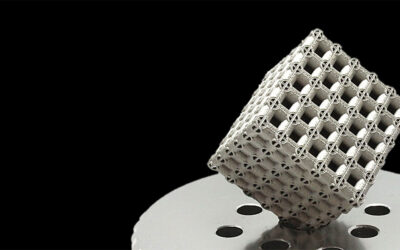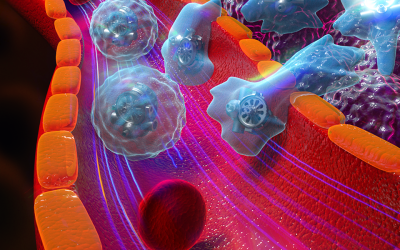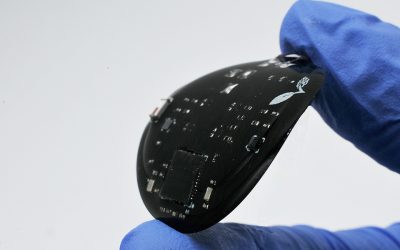A new study has found that “waviness” in forests of vertically-aligned carbon nanotubes dramatically reduces their stiffness, answering a long-standing question surrounding the tiny structures. Instead of being a detriment, the waviness may make the nanotube arrays more compliant and therefore useful as thermal interface material for conducting heat away from future high-powered integrated circuits.
Measurements of nanotube stiffness, which is influenced by a property known as modulus, had suggested that forests of vertically-aligned nanotubes should have a much higher stiffness than what scientists were actually measuring. The reduced effective modulus had been blamed on uneven growth density, and on buckling of the nanotubes under compression.
However, based on experiments, scanning electron microscope (SEM) imaging and mathematical modeling, the new study found that kinked sections of nanotubes may be the primary mechanism reducing the modulus.
“We believe that the mechanism making these nanotubes more compliant is a tiny kinkiness in their structure,” said Suresh Sitaraman, a professor in the Woodruff School of Mechanical Engineering at the Georgia Institute of Technology. “Although they appear to be perfectly straight, under high magnification we found waviness in the carbon nanotubes that we believe accounts for the difference in what is measured versus what would be expected.”
Carbon nanotubes provide many attractive properties, including high electrical and thermal conductivity, and high strength. Individual carbon nanotubes have a modulus ranging from 100 gigapascals to 1.5 terapascals. Arrays of vertically-aligned carbon nanotubes with a low density would be expected to a have an effective modulus of at least five to 150 gigapascals, Sitaraman said, but scientists have typically measured values that are four orders or magnitude less – between one and 10 megapascals.

(Left to right) Georgia Tech Ph.D. student Wei Chen, Professor Suresh Sitaraman and Ph.D. student Nick Ginga examine a carbon nanotube sample against a backdrop of scanning electron microscope images of carbon nanotubes. Image: Georgia Tech/Rob Felt.
To understand what might be causing this variation, Sitaraman and Ph.D. students Nicholas Ginga and Wei Chen studied forests of carbon nanotubes grown atop a silicon substrate, then covered the tips of the structures with another layer of silicon. They then used sensitive test apparatus – a nanoindenter – to compress samples of the nanotubes and measure their stiffness. Alternately, they also placed samples of the silicon-nanotube sandwiches under tensile stress – pulling them apart instead of compressing them.
What they found was that the effective modulus remained low – as much as 10,000 times less than expected – regardless of whether the nanotube sandwiches were compressed or pulled apart. That suggests growth issues, or buckling, could not fully account for the differences observed.
To look for potential explanations, the researchers examined the carbon nanotubes using scanning electron microscopes located in Georgia Tech’s Institute for Electronics and Nanotechnology facilities. At magnification of 10,000 times, they saw the waviness in sections of the nanotubes.
“We found very tiny kinks in the carbon nanotubes,” said Sitaraman. “Although they appeared to be perfectly straight, there was waviness in them. The more waviness we saw, the lower their stiffness was.”
They also noted that under compression, the nanotubes contact one another, influencing nanotube behavior. These observations were modeled mathematically to help explain what was being seen across the different conditions studied.
“We took into account the contact between the carbon nanotubes,” said Chen. “This allowed us to investigate the extreme conditions under which the deformation of nanotubes is constrained by the presence of neighboring nanotubes in the forest.”
Though the loss of modulus might seem like a problem, it actually may be helpful in thermal management applications, Sitaraman said. The compliance of the nanotubes allows them to connect to a silicon integrated circuit on one side, and be bonded to a copper heat spreader on the other side. The flexibility of the nanotubes allows them to move as the top and bottom structures expand and contract at different rates due to temperature changes.
“The beauty of the carbon nanotubes is that they act like springs between the silicon chip and the copper heat spreader,” said Sitaraman. “They can conduct lots of heat because of good thermal properties, and at the same time, they are supple and compliant.”
Carbon nanotubes have extraordinarily high thermal conductivity, as much as ten times that of copper, making them ideal for drawing heat away from the chips.
“The demand for heat removal from chips is continuing to increase,” said Ginga. “Industry has been looking for new materials and new techniques to add to their toolbox for heat transfer. Different approaches will be needed for different devices, and this provides the industry with a new way to address the challenge.”
Source: Georgia Tech

















